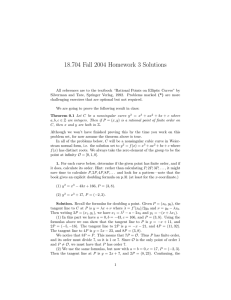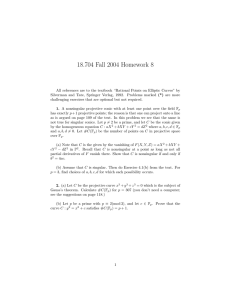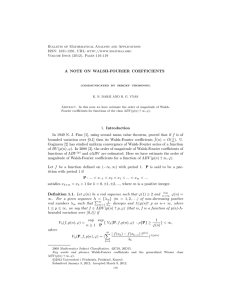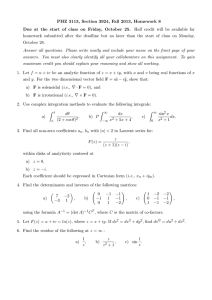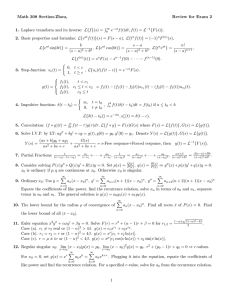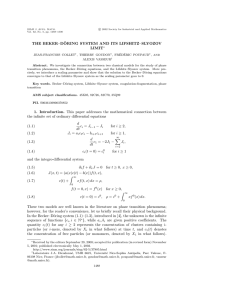18.704 Fall 2004 Homework 3 Due 10/8/04
advertisement
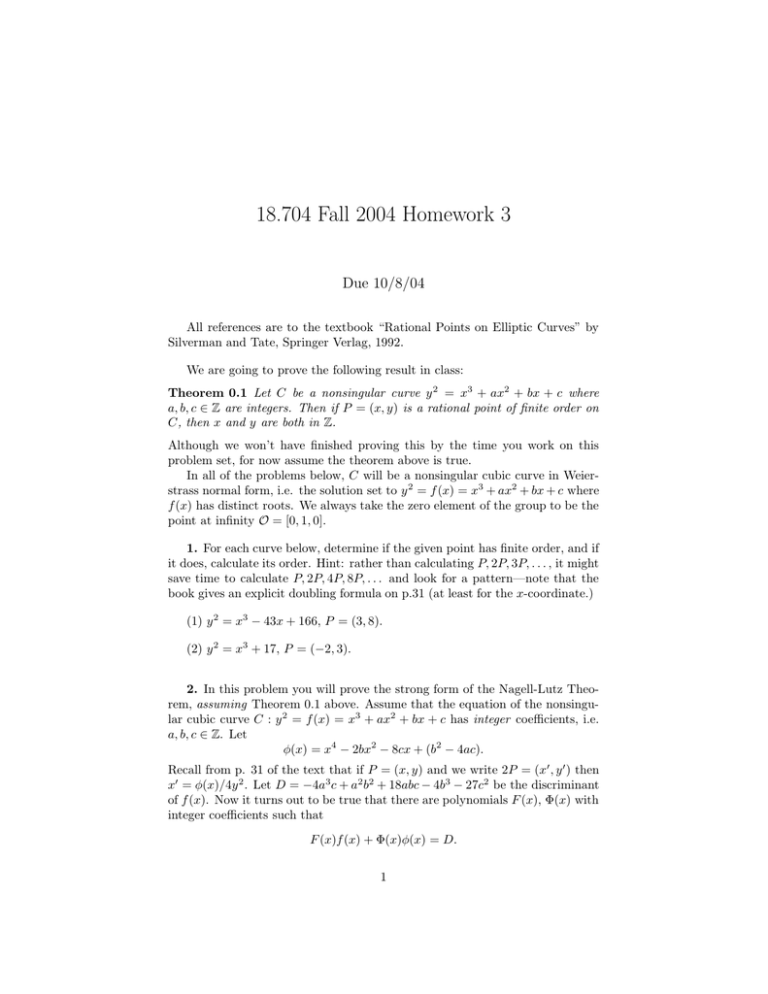
18.704 Fall 2004 Homework 3 Due 10/8/04 All references are to the textbook “Rational Points on Elliptic Curves” by Silverman and Tate, Springer Verlag, 1992. We are going to prove the following result in class: Theorem 0.1 Let C be a nonsingular curve y 2 = x3 + ax2 + bx + c where a, b, c � Z are integers. Then if P = (x, y) is a rational point of finite order on C, then x and y are both in Z. Although we won’t have finished proving this by the time you work on this problem set, for now assume the theorem above is true. In all of the problems below, C will be a nonsingular cubic curve in Weier­ strass normal form, i.e. the solution set to y 2 = f (x) = x3 + ax2 + bx + c where f (x) has distinct roots. We always take the zero element of the group to be the point at infinity O = [0, 1, 0]. 1. For each curve below, determine if the given point has finite order, and if it does, calculate its order. Hint: rather than calculating P, 2P, 3P, . . . , it might save time to calculate P, 2P, 4P, 8P, . . . and look for a pattern—note that the book gives an explicit doubling formula on p.31 (at least for the x-coordinate.) (1) y 2 = x3 − 43x + 166, P = (3, 8). (2) y 2 = x3 + 17, P = (−2, 3). 2. In this problem you will prove the strong form of the Nagell-Lutz Theo­ rem, assuming Theorem 0.1 above. Assume that the equation of the nonsingu­ lar cubic curve C : y 2 = f (x) = x3 + ax2 + bx + c has integer coefficients, i.e. a, b, c � Z. Let �(x) = x4 − 2bx2 − 8cx + (b2 − 4ac). Recall from p. 31 of the text that if P = (x, y) and we write 2P = (x� , y � ) then x� = �(x)/4y 2 . Let D = −4a3 c + a2 b2 + 18abc − 4b3 − 27c2 be the discriminant of f (x). Now it turns out to be true that there are polynomials F (x), �(x) with integer coefficients such that F (x)f (x) + �(x)�(x) = D. 1 You can assume this without proof; it is tedious to determine F and � by hand. (1) (Strong form of the Nagell-Lutz Theorem) Do Exercise 2.11(b) from the text. (2) What is the minimum number of rational points of finite order that a nonsingular cubic curve in Weierstrass form can have (remember to count O)? Find choices of a, b, c � Z so that y 2 = f (x) has this minimal number of them. 3. In this problem we allow the coefficients a, b, c of f (x) to lie in the real numbers R. We saw in class that C : y 2 = f (x) has 9 points of order dividing 3 if one allows complex coefficients. In this problem we are going to see how many of these points have real coefficients. Recall from p. 40 of the text that a point P = (x, y) = � O on C has order 3 if and only if x is a root of the polynomial �(x) = 2f �� (x)f (x) − f � (x)2 = 3x4 + 4ax3 + 6bx2 + 12cx + (4ac − b2 ). Now do Exercise 2.2(b) from the text. 2
